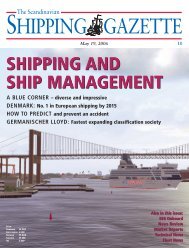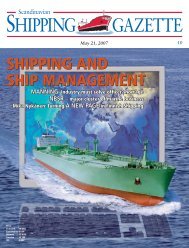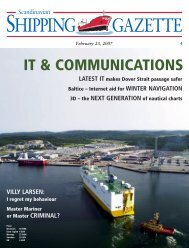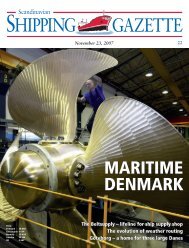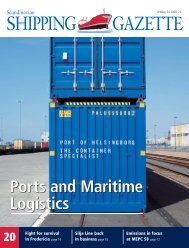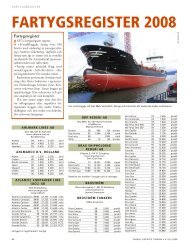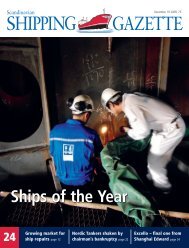SSG No 20 - Shipgaz
SSG No 20 - Shipgaz
SSG No 20 - Shipgaz
You also want an ePaper? Increase the reach of your titles
YUMPU automatically turns print PDFs into web optimized ePapers that Google loves.
PORTS & MARiTiMe lOGiSTiCS<br />
Wind of change<br />
blowing over Danish ports<br />
Mols-linien’s trailer ferry the Maren Mols taking another load of trailers in Kalundborg.<br />
Nearly everybody in the Danish<br />
port environment is holding their<br />
breath at the moment, awaiting the<br />
report from Strukturkommisionen, a government<br />
advisory board, giving its opinion<br />
about the Danish port structure in the<br />
coming 10–15 years. The report is expected<br />
to give a new view on the port structure in<br />
Denmark, leaving the philosophy that the<br />
country should be served by only six major<br />
ports (Copenhagen, Kalundborg, Århus,<br />
Fredericia, Aabenraa and Esbjerg) and the<br />
rest could be sold as resort areas or used for<br />
pleasure craft.<br />
DENMARK<br />
This has changed and now about 18 ports<br />
in Denmark have been much more proactive<br />
in “selling” their harbours and services<br />
to local industry as well as politicians.<br />
In fact the harbour people have taken over<br />
from the developers, which only a few<br />
years ago attacked the harbour owners with<br />
plans for luxury estates with a sea view.<br />
A number of ports were actually converted<br />
to housing areas and by this, the<br />
politicians learned that there was no future<br />
in housing. It does not generate any jobs<br />
in the city, and instead of generating earnings<br />
from the port it creates expenses, as<br />
most of the residents are elderly people,<br />
who will need care and attention within<br />
few years.<br />
Nakskov<br />
An example of the opposite way of thinking<br />
is Nakskov, which has not been the<br />
target for developers. The city and its port<br />
had a serious setback in the middle of<br />
the 1980s when the shipyard was closed<br />
down. Later on the port was used for the<br />
armada of Scandlines ferries laid up for<br />
sale after the closing of the Great Belt<br />
crossing. In later years the shipyard facilities<br />
have been taken over by Vestas, the<br />
wind-turbine manufacturer, which established<br />
a wing factory. The wings are up to<br />
45 metres in length and need to be sailed<br />
out on ships.<br />
The other large production in the city<br />
is refi nery of sugar, which also needs sea<br />
transportation for export overseas. Both<br />
customers in Nakskov havn need more<br />
water depth in the fjord connecting Nakskov<br />
with the Great Belt. A report shows that<br />
an investment of a couple of millions will<br />
generate up to DKK one billion in added<br />
value to the Nakskov area as well as maintaining<br />
some 1,700 jobs in local industry.<br />
This kind report has opened the eyes of<br />
the local politicians, who seem to go for<br />
a future with more jobs and added value<br />
42 SCAnDinAViAn SHiPPinG GAZeTTe • OCTOBeR 26, <strong>20</strong>07<br />
BenT MiKKelSen




